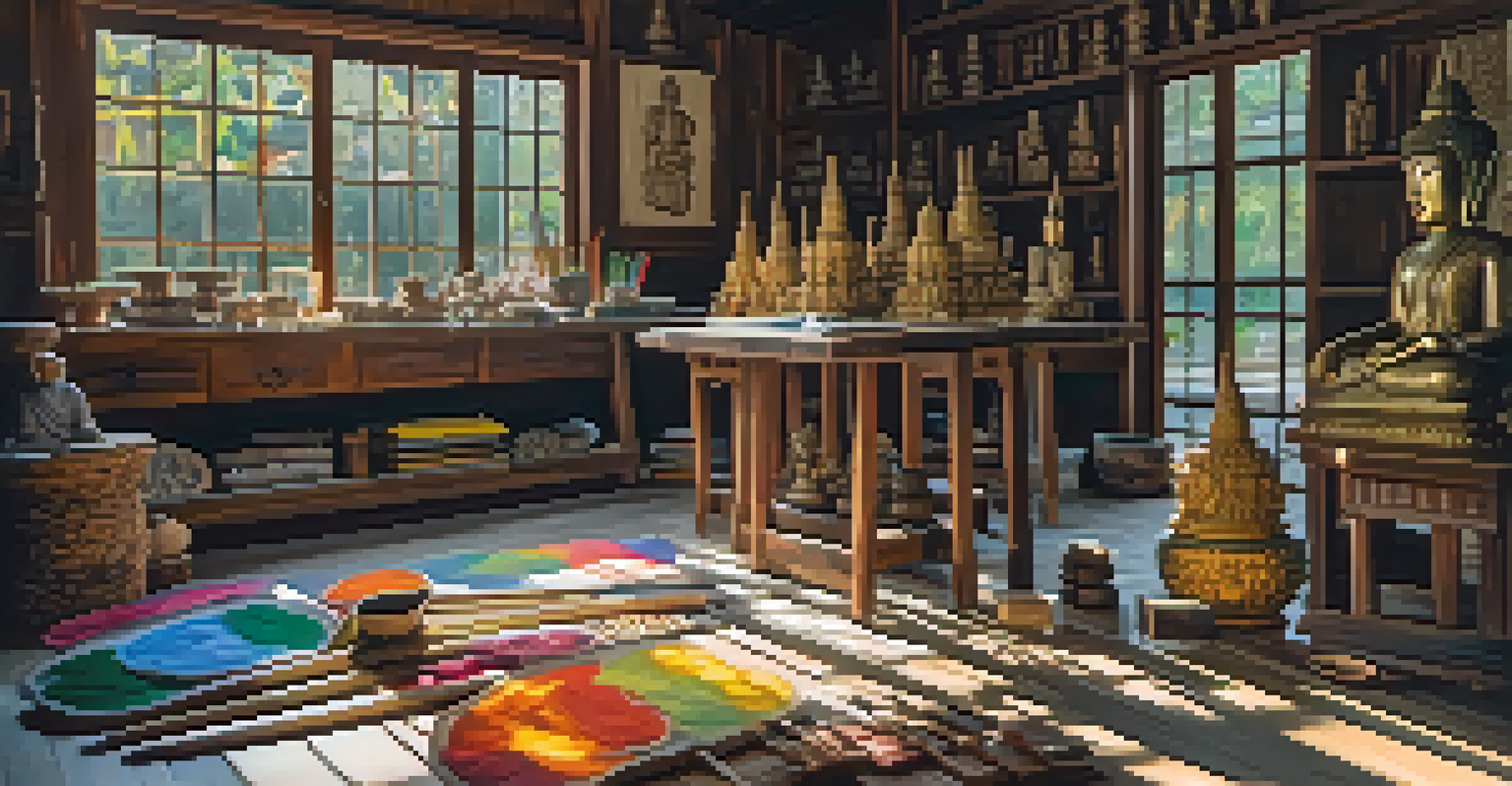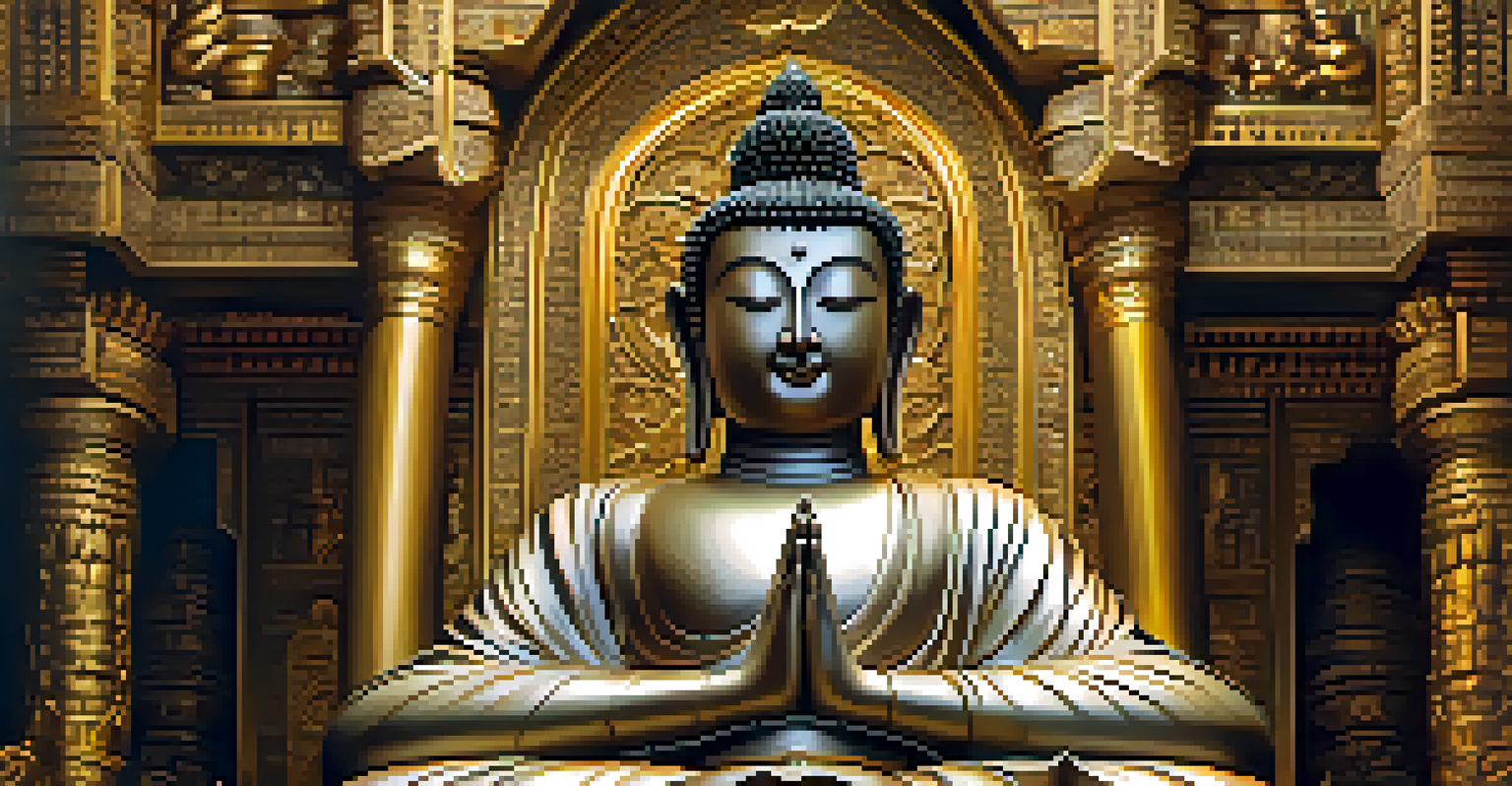Exploring the Influence of Buddhism on Thai Regional Art Styles

Understanding Buddhism's Role in Thai Culture
Buddhism is more than just a religion in Thailand; it's a way of life that permeates daily activities and cultural expressions. This spiritual framework deeply influences various forms of art, from architecture to sculpture, making it integral to Thai identity. The teachings of Buddhism not only provide moral guidance but also inspire creativity and beauty in artistic endeavors.
Art is the most beautiful of all lies.
For instance, many Thai artists draw upon Buddhist themes, depicting scenes from the life of the Buddha or illustrating moral tales through visual art. Temples, or 'wats,' often serve as artistic showcases, featuring intricate murals and statues that communicate spiritual narratives. These artistic expressions are not merely decorative; they play a crucial role in religious ceremonies and community gatherings.
Ultimately, Buddhism offers a rich tapestry of symbols and stories that artists can weave into their works. This symbiotic relationship between faith and art fosters a unique cultural landscape that reflects the beliefs and values of Thai society.
Key Characteristics of Thai Regional Art Styles
Thai regional art styles are characterized by their diversity, each reflecting the local customs and historical influences. From the ornate designs of Central Thailand to the vibrant colors of the North, each region tells its own story through art. Despite these differences, a common thread remains: the influence of Buddhist themes that resonate throughout.

For example, the intricate wood carvings of the northern region often depict celestial beings and scenes from Buddhist scripture, showcasing the connection between craftsmanship and spirituality. Similarly, the golden stupas and murals found in Central Thailand's temples reflect the grandeur of Buddhist architecture and artistry. This regional variation enriches the overall artistic landscape, inviting exploration and appreciation.
Buddhism Shapes Thai Cultural Identity
Buddhism deeply influences Thai art, architecture, and daily life, making it an integral part of the country's cultural identity.
By examining these unique styles, one can see how local traditions harmonize with Buddhist principles, creating a cohesive yet diverse cultural expression. This interplay between local customs and religious influence helps to shape a distinct Thai identity that continues to evolve.
Buddhist Symbolism in Thai Art
Buddhist symbolism is a cornerstone of Thai art, serving as a visual language that conveys complex spiritual concepts. Artists often incorporate symbols such as the lotus flower, which represents purity and enlightenment, or the dharma wheel, symbolizing the path to spiritual awakening. These symbols are not just decorative; they hold profound meanings that invite viewers to reflect on their own spiritual journeys.
The purpose of art is not a rarified, intellectual distillate; it is life, intensified, brilliant life.
In Thai paintings and sculptures, these symbols are often depicted with great care, ensuring that their significance is preserved. For instance, a statue of the Buddha may be adorned with specific hand gestures, or 'mudras,' each conveying a unique teaching or aspect of his life. This attention to detail enriches the viewer's experience and deepens their understanding of Buddhist philosophy.
Moreover, the use of symbolism allows artists to communicate timeless messages across generations. As viewers engage with these works, they are not only experiencing art but also participating in a dialogue about faith, morality, and the human experience.
The Influence of Regional Materials on Art
The materials used in Thai art are heavily influenced by regional availability, which in turn shapes the artistic styles unique to each area. For example, the northern regions are known for their use of local teak wood for intricate carvings, while southern regions often utilize limestone and coral for their sculptures. This reliance on local materials not only supports the regional economy but also enriches the authenticity of the art produced.
In addition, the choice of materials often reflects the spiritual significance of the artwork. Gold leaf, commonly used in temple decorations, symbolizes the divine and the sacred, making it a favored choice for pieces intended for religious use. Artists carefully select materials that enhance the aesthetic and spiritual quality of their work, demonstrating a deep respect for both tradition and artistry.
Diverse Regional Art Styles Exist
Each region of Thailand boasts unique art styles that reflect local customs and historical influences while incorporating Buddhist themes.
Thus, the interplay between regional materials and Buddhist themes creates a dynamic artistic environment where local resources are transformed into profound expressions of faith. This relationship illustrates how art is not only a reflection of culture but also a product of its environment.
Buddhism's Impact on Thai Architecture
Thai architecture, particularly in the context of religious buildings, showcases the profound influence of Buddhism. Temples, with their soaring stupas and ornate decorations, serve as visual representations of Buddhist cosmology, embodying the teachings and values of the faith. The architectural style is not only functional but also deeply symbolic, inviting contemplation and reverence.
One of the most iconic examples is Wat Phra Kaew in Bangkok, whose architecture reflects a blend of traditional Thai and Khmer styles. The intricate details, vibrant colors, and overall layout are designed to inspire awe and facilitate spiritual reflection. Each element, from the rooflines to the statues, is purposefully crafted to create a harmonious space that connects worshippers with the divine.
Moreover, the evolution of Thai architectural styles over time mirrors the changing interpretations of Buddhism itself. As new ideas and influences emerge, they are integrated into the existing framework, allowing the architecture to adapt while still honoring its roots. This dynamic relationship highlights how spirituality continuously shapes and reshapes the built environment.
Traditional vs. Contemporary Thai Art
The dialogue between traditional and contemporary Thai art illustrates the ongoing evolution of Buddhist influence in the modern era. While traditional art often reflects classical techniques and themes, contemporary artists are increasingly experimenting with new forms and materials, all while maintaining a connection to their Buddhist roots. This fusion creates a vibrant artistic landscape that resonates with both local and global audiences.
For instance, contemporary artists may incorporate modern technology, such as digital media, to express traditional Buddhist themes. This approach allows them to reach a broader audience while still paying homage to the cultural and spiritual heritage of Thailand. Exhibitions showcasing this blend not only celebrate the past but also explore the relevance of Buddhism in today’s world.
Future of Thai Art Embraces Change
Emerging Thai artists are blending traditional Buddhist elements with contemporary techniques, signaling a dynamic evolution in the art scene.
Ultimately, the evolution of Thai art reflects a dynamic interplay between tradition and innovation. By embracing change while honoring their roots, Thai artists continue to inspire and engage, ensuring that the influence of Buddhism remains a vital part of the cultural conversation.
The Future of Buddhism in Thai Art
As Thailand navigates the complexities of modernity, the future of Buddhism's influence on art remains a topic of profound interest. Emerging artists are increasingly exploring new ways to express their spiritual beliefs, often challenging traditional norms while staying true to their cultural identity. This evolution signals a bright future for Thai art that embraces both heritage and innovation.
Furthermore, as globalization continues to shape artistic trends, Thai artists have the opportunity to share their unique perspectives on Buddhism with a global audience. Collaborations with international artists can foster cross-cultural dialogue, enriching both local and global art scenes. This exchange not only highlights the universality of Buddhist themes but also enhances appreciation for Thai cultural expressions.

In conclusion, the future of Buddhism in Thai art is poised to be as rich and diverse as its past. By remaining open to new ideas and collaborations, artists can continue to create works that resonate with both their heritage and the contemporary world, ensuring that the profound influence of Buddhism remains vibrant for generations to come.